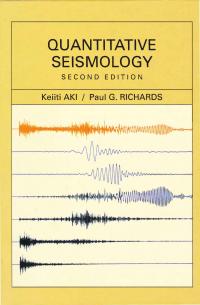Quantitative Seismology
Quantitative Seismology
By: Keiiti Aki, Paul Richards
This book provides a unified treatment of seismological methods that will be of use to advanced students, seismologists, and scientists and engineers working in all areas of seismology.
For all sales outside of the United States, please contact Felicity Henson, fhenson@aip.org
Title information
This new edition of the classic text by Aki and Richards has at last been updated throughout to systematically explain key concepts in seismology. Now in one volume, the book provides a unified treatment of seismological methods that will be of use to advanced students, seismologists, and scientists and engineers working in all areas of seismology.
1. Introduction
Suggestions for Further Reading
2. Basic Theorems in Dynamic Elasticity
2.1 Formulation
2.2 Stress-Strain Relations and the Strain-Energy Function
2.3 Theorems of Uniqueness and Reciprocity
2.4 Introducing Green's Function for Elastodynamics
2.5 Representation Theorems
2.6 Strain-Displacement Relations and Displacement-Stress Relations in General Orthogonal Curvilinear Coordinates
Suggestions for Further Reading
Problems
3. Representation of Seismic Sources
3.1 Representation Theorems for an Internal Surface: Body-Force Equivalents for Discontinuities in Traction and Displacement
3.2 A Simple Example of Slip on a Buried Fault
3.3 General Analysis of Displacement Discontinuities across an Internal Surface E
3.4 Volume Sources: Outline of the Theory and Some Simple Examples
Suggestions for Further Reading
Problems
4. Elastic Waves from a Point Dislocation Source
4.1 Formulation: Introduction of Potentials
4.2 Solution for the Elastodynamic Green Function in a Homogeneous, Isotropic Unbounded Medium
4.3 The Double-Couple Solution in an Infinite Homogeneous Medium
4.4 Ray Theory for Far-Field P-waves and S-waves from a Point Source
4.5 The Radiation Pattern of Body Waves in the Far Field for a Point Shear Dislocation of Arbitrary Orientation in a Spherically Symmetric Medium
Suggestions for Further Reading
Problems
5. Plane Waves in Homogeneous Media and Their Reflection and Transmission at a Plane Boundary
5.1 Basic Properties of Plane Waves in Elastic Media
5.2 Elementary Formulas for Reflection/Conversion/Transmission Coefficients
5.3 Inhomogeneous Waves, Phase Shifts, and Interface Waves
5.4 A Matrix Method for Analyzing Plane Waves in Homogeneous Media
5.5 Wave Propagation in an Attenuating Medium: Basic Theory for Plane Waves
5.6 Wave Propagation in an Elastic Anisotropic Medium: Basic Theory for Plane Waves
Suggestions for Further Reading
Problems
6. Reflection and Refraction of Spherical Waves; Lamb's Problem
6.1 Spherical Waves as a Superposition of Plane Waves and Conical Waves
6.2 Reflection of Spherical Waves at a Plane Boundary: Acoustic Waves
6.3 Spherical Waves in an Elastic Half-Space: The Rayleigh Pole
6.4 Cagniard-De Hoop Methods for Line Sources
6.5 Cagniard-De Hoop Methods for Point Sources
6.6 Summary of Main Results and Comparison between Different Methods
Suggestions for Further Reading
Problems
7. Surface Waves in a Vertically Heterogeneous Medium
7.1 Basic Properties of Surface Waves
7.2 Eigenvalue Problem for the Displacement-Stress Vector
7.3 Variational Principle for Love and Rayleigh Waves
7.4 Surface-Wave Terms of Green's Function for a Vertically Heterogeneous Medium
7.5 Love and Rayleigh Waves from a Point Source with Arbitrary Seismic Moment
7.6 Leaky Modes
Suggestions for Further Reading
Problems
8. Free Oscillations of the Earth
8.1 Free Oscillations of a Homogeneous Liquid Sphere
8.2 Excitation of Free Oscillations by a Point Source
8.3 Surface Waves on the Spherical Earth
8.4 Free Oscillations of a Self-Gravitating Earth
8.5 The Centroid Moment Tensor
8.6 Splitting of Normal Modes Due to the Earth's Rotation
8.7 Spectral Splitting of Free Oscillations Due to Lateral Inhomogeneity of the Earth's Structure
Suggestions for Further Reading
Problems
9. Body Waves in Media with Depth-Dependent Properties
9.1 Cagniard's Method for a Medium with Many Plane Layers: Analysis of a Generalized Ray
9.2 The Reflectivity Method for a Medium with Many Plane Layers
9.3 Classical Ray Theory in Seismology
9.4 Inversion of Travel-Time Data to Infer Earth Structure
9.5 Wave Propagation in Media Having Smoothly Varying Depth-Dependent Velocity Profiles within Which Turning Points Are Present
9.6 Body-Wave Problems for Spherically Symmetric Earth Models in Which Discontinuities are Present between In homogeneous Layers
9.7 Comparison between Different Methods
Suggestions for Further Reading
Problems
10. The Seismic Source: Kinematics
10.1 Kinematics of an Earthquake as Seen at Far Field
10.2 Kinematics of an Earthquake as Seen at Near Field
Suggestions for Further Reading
Problems
11. The Seismic Source: Dynamics
11.1 Dynamics of a Crack Propagating with Prescribed Velocity
11.2 Dynamics of Spontaneous Planar Rupture Propagation
Suggestions for Further Reading
Problems
12. Principles of Seismometry
12.1 Basic Instrumentation
12.2 Frequency and Dynamic Range of Seismic Signals and Noise
12.3 Detection of Signal
Suggestions for Further Reading
Problems
Appendix 1: Glossary of Waves
Appendix 2: Definition of Magnitudes
Index
|
“The continued popularity of this text is testament to the meticulous detail with which important mathematical formulas are derived; there simply is nothing of any importance that is glossed over or omitted.” “An excellent study and reference book for seismologists well-grounded in the methods of mathematical physics. This updated version of Aki and Richard’s classical geophysical text deserves a place in every serious geophysicist’s library.” “For more than twenty years, Aki and Richards’ classic has maintained its position as the most complete and accessible text on theoretical seismology. Now brought up to date throughout, and with several completely revised chapters, this book will remain “The Bible” of the subject for years to come.” “An important renewal of a classic geophysics text. The clarity of the chapters that describe fundamental seismic wave propagation remains undiminished.” “Still the preeminent text on analytic theory and methods in seismology.” From reviews of the first edition: “This truly exquisite text/monograph provides advanced students and professionals with a wonderfully detailed and comprehensive but lucid account of physical, mathematical and instrumentational principles that lie at the quantitative heart of modern seismology…An extraordinary publishing event.” |

